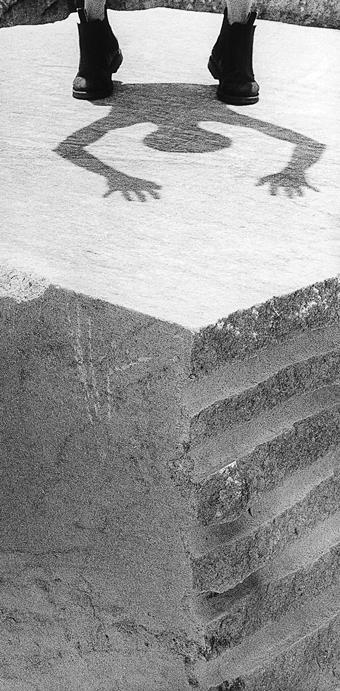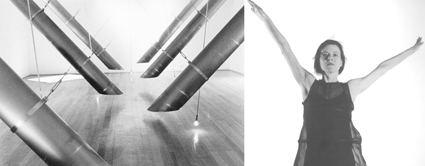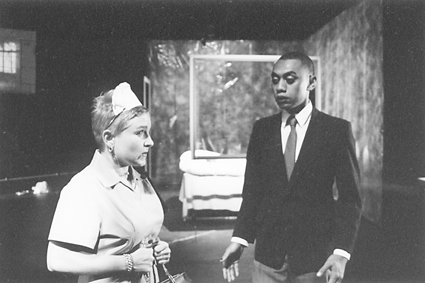Works in progress: hybrid performance
Back to Back Theatre, Beaubois, Bonemap, Felber, PACT Youth Theatre, Trash Vaudeville, The Men Who Knew Too Much
Back to Back Theatre
Soft
A collaboration between Back To Back Theatre and Deakin University’s School of Architecture, Soft is a performance merging architectural design, virtual and live performance, character animation and surround sound. Soft will take place in a purpose-built architectural structure and utilise a diversity of media to realise the performers’ inner worlds. The venue will be a purpose-built, inflatable unit or self-supporting structure incorporating a 360 degree projection membrane with surround sound. It will include elements of virtual architecture with the capacity to respond to the actions of performers.
Established in 1987, Back to Back Theatre operates around an ensemble of professional performers with intellectual disabilities. Recent artistic work employs digital technology for pre-production, documentation, show control and operating technology.
Collaborators: Rita Halabarec, Mark Deans, Darren Riches, Nicki Holland, Sonia Teuben (actors/devisers), Bruce Gladwin (director), Julianne O’Brien (dramaturg), Hugh Covill (sound design), Professor Mark Barry with students of Architecture & Building, Deakin University, Geelong (physical and virtual design), Efterpi Soropos (lighting design), Anna Tregloan (costume design).
Creative development period July-December 2000.New Media Arts Fund, Australia Council; Arts Victoria.
Denis Beaubois
Group Stare #1 and #4
A situation is created where a group of strangers is divided into 2 groups, separated and invited to look at each other, each individual given a partner to look at from the other group. At any time they may leave the room and their partner choose to refocus their gaze on another person.
The group stare is a closed system which generates its own performative platform where the viewer is also the performer. The work is exhibited as 2 projections side by side. The initial impact in the gallery provides an impression of a crowd (possibly an audience) looking back at the viewer. This crowd appears to be reacting to something outside the camera’s field of vision. As more time is spent with the work, a relationship can be derived between the people from the different screens.
Denis Beaubois’ practice includes performance, video and photography. His works have been performed and exhibited throughout Australia, New Zealand, Germany, Spain, South America and the US. In 1998 he performed in New York and at the Cleveland Festival of Performance Art. He was the winner of Bonn Videonale 8 in Germany. In 1999 he was the resident guest artist at the Artist Unlimited Group in Bielefeld Germany and is currently artist in residence at the University of NSW. His work, Writing, is exhibited as part of Spectrascope at Performance Space (see page 2).
Group Stare is an ongoing project which has been exhibited in Bielfeld, Germany and was recently shown at BUNKER @ Linden Gallery in St Kilda as well as being performed at the Canberra Contemporary Art Space. New Media Arts Fund, Australia Council.
Bonemap
the wild edge

Bonemap
Bonemap the wild edge dance | screen | sound | image | object is a site-specific artwork emphasising the ephemeral body via the social and natural landscape. The artists interpret contrasts between the tropical Australian environment and the ‘wild edge’ of urban and built spaces. Exploring relationships of the moment and notations of identity and place sees performance, multimedia, exhibition, installation and sound composition merge into the wild edge. Available as discrete modules.
Challenges: reconnaissance and personal knowledge of sites; small crew multi-tasking in diverse and distant locations; meteorological and extreme environmental effects on technical equipment (sun, water, tiny insects inside camera lens); and stretching of human/technical resources.
Russell Milledge is an artist, curator and consultant. His performance, sculpture, installation art, interface design and multimedia work is collaborative and represented in the collections of Queensland Art Gallery and Cairns Regional Gallery. Rebecca Youdell is a choreographer and performer working in contemporary dance via site-specific collaborations involving multimedia, installation and performance. Collaborators: Glen O’Malley, Michael Whiticker and Paul Lawrence. info@bonemap.com.
the wild edge has been presented in Cairns and Tokyo and will be seen in Townsville in August and as part of l’attitude 27.5º at Brisbane Powerhouse, Septermber 9 – 25. Australia Council, Arts Queensland, The Choreographic Centre (ACT), Cairns City Council. www.bonemap.com
Joe Felber
25 Songs…

Joe Felber, 25 Songs, dancer Lucy Guerin
25 Songs on 25 Lines of Words on Art Statement for Seven Voices and Dance is a collaborative work between artist Joe Felber, composer Elliott Gyger and dancer Lucy Guerin, each of whom is responding directly to American painter Ad Reinhardt’s famous 25 Lines of Words on Art Statement. The 3 artists have created a theatre of response, reconsidering Reinhardt’s seminal 1958 writing on abstraction, art and modernism through the creation of a work combining music, image, video and dance.
Involving interdisciplinary arts practice and new media technology, the installation runs from the Cubase program. The video, stills photography and text graphics were created on Adobe After Effects and Premiere. The Pendulums run on a 12 volt magnet call from 2 transformers.
Joe Felber is an Australian citizen of Swiss origin. He completed an architectural draftsman apprenticeship in Switzerland and Master in Art (sculpture) at RMIT. His is a pluralistic arts practice including painting, photography, video and new media art. He has exhibited internationally since 1985 in New York, Europe and Australia.
This work toured Australia and Singapore and will be shown October-December 2001 at the Minioriten in Graz and Landesgalerie, Ladesmuseum in Linz Austria. Australia Council for the Arts, Pro Helvetia, Switzerland, Credit Suisse Group, Singapore.
PACT Youth Theatre
Replicant Hotel

Replicant Hotel, PACT Youth Theatre
photo Heidrun Löhr
Replicant Hotel, PACT Youth Theatre
Replicant Hotel is a contemporary performance work incorporating collaborative writing and performance processes. The performance is layered with media archives or keyholes strewn about the hotel, a refuge for Replicants (read anything from Poe to Blade Runner).
Replicant Hotel centres on 5 figures abandoned by the 20th century. We have a Bell Boy (sometimes encountered in multiples) who is always intervening in potential wars with a calming soup. Voltaire, that populist journalist, is pronouncing revolution and croissants from his bedroom podium while cities crumble in the distance. Television Boy is locked to the Box, in love with the trickle of images that keep him awake at night. A painter is escaping his own portrait and a charming maid plays out movie scenes behind the curtains.
The challenges of this production include the integration of 5 distinct aesthetics supplied by 5 writers and the incorporation of pre-recorded “archives” (video, sound, film) based on the writing and performance making process. Novelist and dramaturg Mireille Juchau has been working with a small group of emerging writers: Shelley O’Donnell, Brian Fuata, Roanna Gonsalvez, Adrian Chiarella and Sarah Rodigari. Together they are plotting an intricate web of moments, each informed by a central figure that has fascinated them in the wake of the 20th century. This work is then fed into the performance group who interpret, rip and tear at the material to develop a performance labyrinth.
Collaborators: Caitlin Newton-Broad (director), Mireille Juchau (dramaturg & writing facilitator), Samuel James (space & media design), Gail Priest (sound designer), Richard Manner (lighting design).
Completion: August 2000. New Media Arts and Theatre Funds, Australia Council, NSW Ministry for the Arts, South Sydney Council.
Trash Vaudeville
Loose End
The focus of this new work is a process of experimentation using projected animation sequences and live performance. Animation, produced using clunky but vibrant analogue technology, is projected onto large screens and mixed with the live performer to tell a seedy story of finding desire and losing your mind. Two characters inhabiting the peripheries of gay life cross paths on the stroke of midnight. Loose End traces the ensuing havoc.
Trash Vaudeville
A work in development, Loose End is an investigation into the total integration of performer and projection. Animated sequences run across 3 screens. Some animations run solo, some involve actual highlighted spaces for the performer to become part of the animation and to interact with the projected characters. The work is quite literal in its methods of integration creating the effect of a cartoon character coming to life. The body/image integration works particularly well when the animations are used to stretch reality—when a cat transforms into a man, or the soul leaves a battered body and flies up to the heavens. The strength of the work is that the technology is used to expand reality, without losing the special vibrancy that can only be created by the presence of the living, breathing body on stage. Gail Priest
Direction, animation and performance Trash Vaudeville, sound & audio visual management Severin Sieben, set construction Chris Fox, lighting design David Darker. Performance Space, Sydney, July 15 – 17
The Men WHo Knew Too Much
Virtual Humanoids
![]()
The Men Who Knew Too Much, Virtual Humanoids
Melbourne’s Planetarium as a performance venue was an inspired choice by The Men Who Knew Too Much. In this space Virtual Humanoids was a wondrous meeting of interfaces; electronic art and absurdism, screen and stage, live and virtual, human bodies and computerised voices. The venue’s white dome-shaped roof functioned as more than the computer screen: it enveloped audience bodies leaning back in their chairs angled towards the horizontal. Projected images floated across laid-out torsos and upturned faces. A disembodied humanoid voice as director seems almost a family familiar tucking us in for the night—Hal meets Star Trek’s Spock.
Enter 6 male performers. Writer-designer Simon Hill, Patrick Cronin, Louis Dingemans and Richard Gray, live, vertical, human-like in dark suits and heavy-rimmed glasses delivering pithy lines. Peter Eckersall appeared on-screen, often only in ice blue, pinkish outlines of his head. Music and VR creator Adam Nash played the hacker, Setarcos, live, seated, driving the images on the dome screen and emailing longingly to the only visible woman, Yasuka Yohama, who emails back that she is virtual. Performance director was Susie Dee.
Virtual Humanoids is an early 21st century reinvention of the variety show: jokey, blokey, silly, amusing, beguiling, techno-savvy and clever. Larger-than life images of Man in evolution up to the stage of ‘suits’ ringed the dome, a blue-suited, headless virtual singer cloned as wall-paper, a Martian selling white-goods, gigantic table settings, a cyber housefly at the cyber fly port. The net refracted through domestic life. The show performed the aesthetics of the internet surf, short fast grabs seemingly at random, except that The Men’s web search deliberately brought up cultural clashes and longstanding anxieties; dehumanised corporate men, robotic unthinking behaviour, a cross-dressed bride, an electronic maze.
Screen images alternated back streets and identikit houses, with abstract computer generated figures and patterns, several of which were sensationally beautiful mobiles and sensory tunnels. Hilarious web pages with extreme environmental messages pointed towards alienated ineffectualness—trees as information lists. If the show’s gentle humour highlighted the deliciousness of human opportunism and games in the dotcom world, it’s form linked the disembodiment of dotcoms to dehumanising corporate norms. The ideas are not new. They have a history as the nostalgic use of lines from 60s comedy attested. However, making connections between the web’s illogicality and its market driven commercialism is a crucial message towards awareness of the consequence of social life mediated by on-line languages.
Virtual Humanoids’ polished, stylised format integrated its digital imagery completely with live sequences. Electronic technology was used in the artmaking, not merely as the broadcast medium. I found myself silently disputing Philip Auslander’s claim that the televisual invariably dominates liveness. My attention roamed equally between the performers’ faces and screen images, perhaps because their bodies were in a life-like scale to my own in the second row but also because their faces were specially lit.
The production confirmed my view that much of the new media arts retains the distinctions of artistic disciplines. This work was clearly performed to and for an audience who like theatre, with even the obligatory participation when one spectator was singled out to be photographed and scanned onto a suited body in the virtual world. This approach is quite different to the stand-alone electronic screens in the visual arts where flat gallery walls become huge screens or miniaturised monitors are hidden in other objects or multiples function like mundane sculpture, for example the shopping-mall aura of Nam June Paik’s latest work. Or where galleries overseas must employ attendants to encourage visitors to interactively click and scroll the artwork on screens like those they have at work. Because new technologies are already so advanced in corporate and game delivery, and webcam broadcasting seems to have been co-opted by the sex industry, innovation in electronic screen performance needs to generate more than technological presence in image display or more immediate script access. At least New York computer installation artist Toni Dove and dancers like Company in Space ‘move’ the technology imaginatively.
Virtual Humanoids also offers an innovative approach with its comic expressiveness and captivating spaces that expose the failings, foibles and duplicity of these new technologies we love. Peta Tait
Virtual Humanoids, The Men Who Knew Too Much, Melbourne Planetarium, Scienceworks, July 19-30
RealTime issue #38 Aug-Sept 2000 pg. 15,17,18






